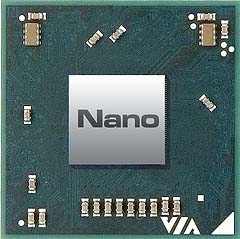Via finally releases new Nano processor


Via has spent years working on Nano, which represents a major leap forward from the C7. By now, the technical details are well known. Specifically, Nano has many of the microarchitectural features--64-bit x86 instruction set, superscalar pipeline, speculative and out-of-order execution of program instructions--found in advanced Intel or AMD chips.
Manufactured by Fujitsu using 65nm process technology, Nano has 94 million transistors--roughly twice as many as the C7--and measures 63.3 square millimeters. That translates to about 1,000 chips on a single, 300mm silicon wafer. Nano is significantly larger than both the C7-M (30 square millimeters) and Intel's Atom (25 square millimeters), which both have a much simpler microarchitecture. Nano is pin-compatible with C7, which means OEMs that already sell small form-factor desktops, ultraportables or UMPCs with Via processors should be able to easily upgrade.
Because Nano offers significantly better performance than the C7, Via is going after a broader market. The L version (for Low Voltage) is designed for mainstream desktops and notebooks, and it will compete directly with Intel's low-end mobile processors such as Celeron-M and Core 2 Solo. The U version (Ultra Low Voltage) version is designed for mini-notebooks and UMPCs, and it will compete with Intel's new Atom, aka Silverthorne. All Nano processors have 1MB of L2 cache.
| Model | Frequency | FSB | Max power (TDP) | Idle power |
| Nano U2300 | 1.0GHz | 800MHz | 5 watts | 100mW |
| Nano U2500 | 1.2GHz | 800MHz | 6.8 watts | 100mW |
| Nano U2400 | 1.3GHz | 800MHz | 8 watts | 100mW |
| Nano L2200 | 1.6GHz | 800MHz | 17 watts | 100mW |
| Nano L2100 | 1.8GHz | 800MHz | 25 watts | 500mW |
Via's competitive advantage has been in power efficiency, and the specs for Nano look impressive. The high-end processors consume a maximum of 17 to 25 watts, and the ultra low-voltage versions top out at 5 to 8 watts, depending on the clock speed. When the chip is idle, it consumes anywhere from 0.1 watts for the 1.0GHz U2300 to 0.5 watts for the fastest 1.8GHz L2800. For comparison, here are the specs for the initial Intel Atom processors, announced last month.
| Model | Frequency | FSB | Max power (TDP) | Idle power | Price |
| Atom Z500 | 800MHz | 400MHz | 0.65 watts | 80mW | $45 |
| Atom Z510 | 1.10GHz | 400MHz | 2 watts | 100mW | $45 |
| Atom Z520 | 1.33GHz | 533MHz | 2 watts | 100mW | $65 |
| Atom Z530 | 1.60GHz | 533MHz | 2 watts | 100mW | $95 |
| Atom Z540 | 1.86GHz | 533MHz | 2.4 watts | 100mW | $160 |
Via says it has already shipped Nano processors to OEMs, and they will start to show up in systems sometime in the third quarter. The pricing hasn't been announced, though it will almost certainly be very aggressive, as Via is promising the lowest-priced systems capable of handling Blu-ray high-definition movies. Also, watch for some news from Nvidia on its work to develop GPUs, and eventually chipsets, for Nano that should result in some of the lowest-cost DirectX 10-capable systems. There are many mini-notebook and UMPC design based on the C7--including Via's own OpenBook and the HP 2133 Mini-note--so it's no surprise that Via also plans to keep it around for a while.